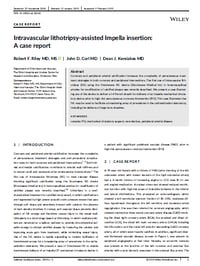Top 5 PAD Publications of 2019
It’s that time of year where there seems to be a countdown for everything – Top 100 Songs, Top Baby Names, Top 10 Sports Moments of 2019 – We wanted to get in on the fun too and here it is… Top 5 Peripheral IVL Publications from 2019!
2019 was a breakout year for the Shockwave M5 IVL Catheter. While the majority of cases being done are still in the SFA/Popliteal arteries, we saw an increase in use in the CFA and Iliac arteries. We were also surprised at the rapid uptake of IVL in the ilio-femoral segment to facilitate trans-femoral (TF) access for large bore procedures. 2019 saw IVL enabled TF access become a new alternative to alternative access! 2019 also saw an increase in overall clinical evidence being published related to use of IVL in peripheral arteries from 7 publications to 22. Here are the ones we believe to be the Top 5:
- 5. Systematic Review
- This expert review article not only provides an overview of the Shockwave sponsored studies, but also several case series and reports. The authors suggest the capacity to preferentially disrupt calcium, in a controlled manner, may find a growing role in endovascular interventions, may optimize stent delivery and may be particular useful to treat tibial artery calcification.
- Link to the Publication
- 4. IVL pre Impella
- This case report is the first published report of the use of IVL to facilitate trans-femoral access for insertion of the Impella CP mechanical circulatory support device (Abiomed, Danvers, MA). The calcified iliac artery prevented passage of the introducer sheath despite multiple attempts with PTA. However, following treatment with IVL, the 14Fr sheath was safely inserted, allowing for a supported PCI procedure. Viewing this manuscript online is suggested, as there are compelling angiography videos.
- Link to the Publication
- 3. IVL preTEVAR
- This case report is the first published report of the use of IVL to facilitate trans-femoral access for TEVAR. This patient required intervention for a growing thoracic aorta aneurysm and was a good candidate for an endovascular intervention except for bilateral circumferential calcified iliac arteries. IVL was used to increase the lumen and allow for safe passage of the large sheath required for TEVAR.
- Link to the Publication
2. IVL in CFA
This multi-center, core lab adjudicated analysis of endovascular treatment of calcified common femoral arteries with IVL is the first, and largest cohort to-date. The 21 patients enrolled saw a reduction in residual stenosis 21.3% with no flow-limiting dissections, perforations, distal embolization, thrombus, no relow or abrupt closure. Thus, the conclusion that IVL can be safely and successfully performed in the CFA.
And the top publication for 2019 is ….
This multi-center registry was established to collect prospective outcomes when IVL is used to facilitate trans-femoral access for delivery of large sheaths required for TAVR. Outcomes on 42 patients with prohibitive iliofemoral calcified vascular disease were collected. The authors conclude that by disrupting intimal and medial calcification, IVL alters vessel compliance and allows for safe passage of the delivery sheaths, thus expanding the patient cohort that could be eligible for TAVR procedures.
We can’t wait to see what new publications are in store for 2020! Follow us on Twitter at @ShockwaveIVL or Contact Us on our website to keep up with the latest news.
Important Safety Information
Caution: Federal law (USA) restricts this device to sale by or on the order of a physician.
Indication for Use – The Shockwave Medical Intravascular Lithotripsy (IVL) System is intended for lithotripsy-enhanced balloon dilatation of lesions, including calcified lesions, in the peripheral vasculature, including the iliac, femoral, ilio-femoral, popliteal, infra-popliteal, and renal arteries. Not for use in the coronary or cerebral vasculature.
Contraindications – Do not use if unable to pass 0.014 guidewire across the lesion • Not intended for treatment of in-stent restenosis or in coronary, carotid, or cerebrovascular arteries.
Warnings – Only to be used by physicians who are familiar with interventional vascular procedures • Physicians must be trained prior to use of the device • Use the Generator in accordance with recommended settings as stated in the Operator’s Manual
Precautions – Use only the recommended balloon inflation medium • Appropriate anticoagulant therapy should be administered by the physician • Decision regarding use of distal protection should be made based on physician assessment of treatment lesion morphology
Adverse Effects – Possible adverse effects consistent with standard angioplasty include: • Access site complications • Allergy to contrast or blood thinners • Arterial bypass surgery • Bleeding complications • Death • Fracture of guidewire or device • Hypertension/Hypotension • Infection/sepsis • Placement of a stent • Renal failure • Shock/pulmonary edema • Target vessel stenosis or occlusion • Vascular complications. Risks unique to the device and its use: • Allergy to catheter material(s) • Device malfunction or failure • Excess heat at target site
Prior to use, please reference the Instructions for Use for more information on indications, contraindications, warnings, precautions, and adverse events. www.shockwavemedical.com







